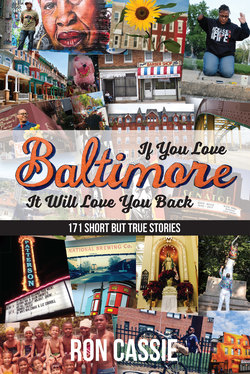Читать книгу If You Love Baltimore, It Will Love You Back - Ron Cassie - Страница 42
На сайте Литреса книга снята с продажи.
ОглавлениеMiddle East
North Collington Avenue
June 22, 2013
32. Pilgrimage
Folklorist Elaine Eff struggles momentarily with the karaoke machine that’s serving as her microphone and speaker. The bus tour she’s leading, the Painted Screen Pilgrimage, is sold out. She passes out maps.
“We’re are in the heart of Highlandtown,” she says, “going to the Lourdes of Painted Screens.”
Heading down Eastern Avenue, Effs points to examples in several rowhouse windows and screen doors—including a glorious image of Patterson Park’s pagoda, drawing “oohs and aahs” from inside the bus. She provides brief neighborhood histories as well, ultimately reaching the birthplace of the painted screen: East Baltimore’s St. Wenceslaus community.
Here, across from the Italianate church, in a neighborhood once known as Little Bohemia, Czech immigrant and butcher William Oktavec painted the first screen window, 100 years ago, advertising his produce and meats. A few door away, mother and homemaker Emma Schott saw Oktavec’s handiwork and a light bulb went off.
“You mean, my husband can sit inside in his underwear, drink a beer, read the newspaper, and no one walking by can see him?” Eff says, mock-imitating Schott. Eff is highlighting, of course, the sidewalk proximity of rowhouse living rooms and the practicality of the screen art before air conditioning.
Oktavec painted Schott a red mill alongside a stream, and soon enough, everyone on the block wanted a painted screen.
The tour also weaves past the former McElderry Park rowhome of Johnny Eck, a legendary “half-man” circus and sideshow performer who became an Oktavec screen painting protégé; then Canton, where a number of original screen paintings remain.
“There’s one my great uncle did,” says Troy Richardson, along for the ride, pointing to a lighthouse image in a window. Richardson’s grandfather Ted and great uncle Ben both became screen painters in the folk art’s 1940s and 1950s Formstone heyday.
Earlier, the Creative Alliance showed Eff’s 30-minute documentary, The Screen Painters. In the film, William Oktavek Jr., whose brother, Richard, and nephew, John, carried on the family tradition and whose works are part of a revival in Highlandtown, talks about his butcher-turned-artist dad and the rowhouse folk art medium he launched.
“What I like about it, is what I like about Baltimore,” Oktavec says. “It’s like Babe Ruth and baseball—that things like this can exist here and endure.”
